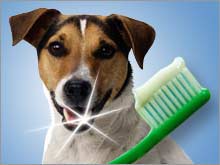 |
| Sales of over-the-counter pet oral hygiene products is expected to cross half-a-billion dollars in 2005. |
|
|
|
|
|
|
|
NEW YORK (CNN/Money) -
Dog breath. Whew!!!
It's a nasty little problem to deal with especially if it's the last thing you whiff before dozing off to sleep -- and worse -- the first thing that jolts you awake every morning along with the jab of a wet nose and a wagging tail on the other end.
American consumers, who dish out billions of dollars each year on their own breath freshening, teeth whitening and gum strengthening products, are becoming increasingly eager to do the same for their dogs, cats and other furry companions.
How eager?
Consider that consumers spent about $425 million dollars last year on over-the-counter pet oral care products, according to a new report from consumer goods research firm Packaged Facts.
In fact, the category's seen a rapid double-digit growth of about 35 percent a year since 2000.
If there is any single factor that prevents owners from caring for their pets' teeth, it's the fact that it probably isn't the most pleasant of activities.
Plus it's often messy, time-consuming, somewhat dangerous, too.
But all that is changing as companies rush to market a slew of more convenient pet breath-busting products that mirror the latest trends in human oral care, everything from breath strips, sprays, swabs, wipes and electric toothbrushes.
"The petcare industry is an incredibly dynamic industry and companies know there is a lot of money to be made," said David Lummis, author of the Packaged Facts report "Market Trends: Oral Care Products for Pets."
Lummis said that while pet tooth cleaning products like biscuits and rawhide chews have been around for a while, it's during the last two years that the pet supplies market has witnessed a surge of new products specifically targeting oral care.
For instance, there were only 23 over-the-counter oral pet hygiene products available to pet owners in 2000. That number jumped to 45 in 2003. This year, 56 new products are expected to hit the market.
According to Lummis, this relatively sudden influx of oralcare-themed products is being fueled by three broad trends led by the continuing "humanization" of pets.
"People have always loved their pets. But after 9/11, that bond with the pets has become stronger," Lummis said. "Marketers have picked up on it and are using it more aggressively to see new products."
Secondly, the rapid expansion of major pet supplies chains like Petco (Research) and PETsMART (Research) over the past decade has extended the awareness and reach of specialty pet products to more consumers nationwide, giving a once niche category a mass-market appeal.
The pet population is growing between 3 to 5 percent a year, according to the American Pet Products Association, which said that about 63 percent of U.S. households either have a dog or a cat.
While pet adoption is on the rise with younger and single consumers, on the other end of the spectrum, Lummis said the aging boomers also represent the "the great white hope of the industry."
"Although pet ownership has historically declined after the age of 55, we believe that aging boomers will fly in the face of this trend," Lummis said. "Aging boomers, who are predominantly white and affluent, have already begun to redefine the pet supplies market reflected in the groundswell of premium-priced products focused on health for pets."
Tierra Griffiths, spokeswoman for the American Pet Products Manufacturers Association, agreed with Lummis.
"We look at two trends that will continue to drive the market for pet oral hygiene," Griffiths said. "The aging boomers will experience the empty next syndrome. With the kids gone, the pet no longer is at the end of the food chain and boomers will spend more time and money on their pets."
"The other factor is the dual income no kids couples," she added. "More and more couples are starting their families with pets but treating them like their children."

|